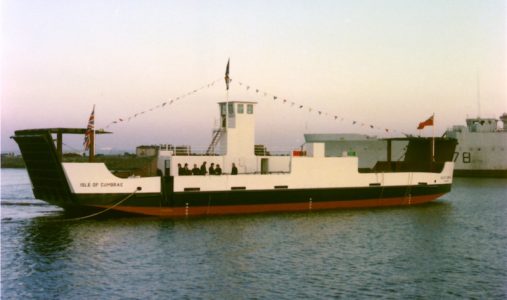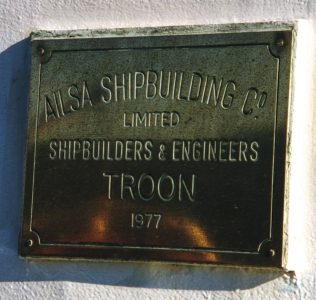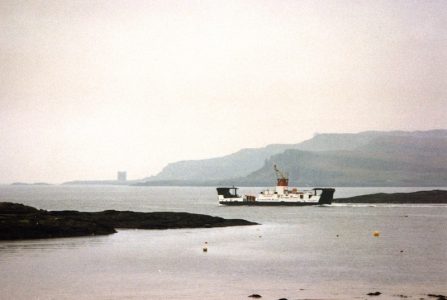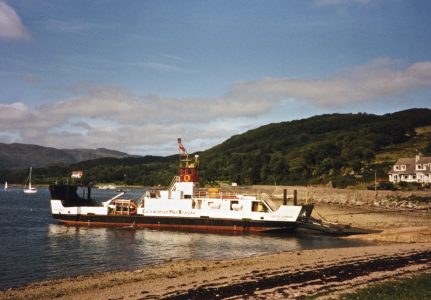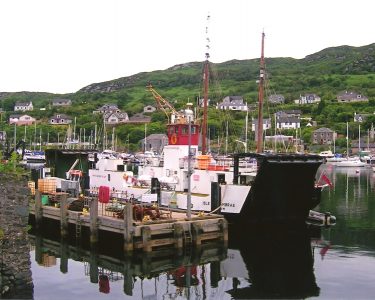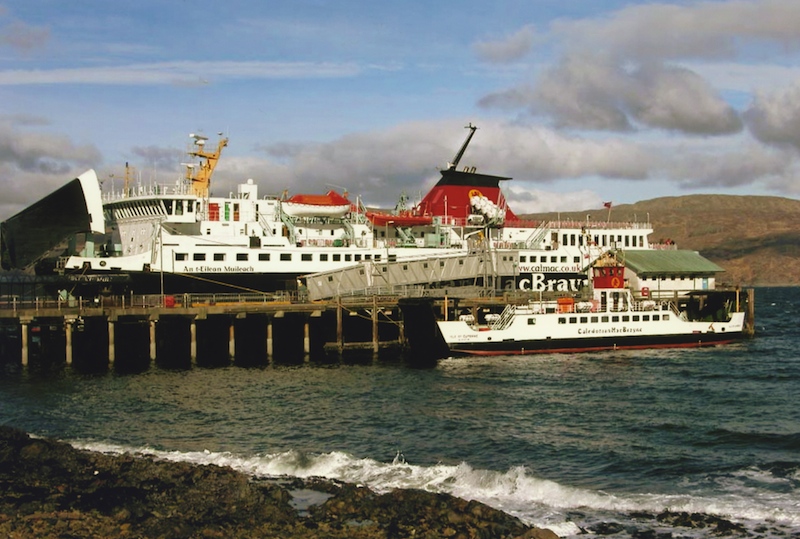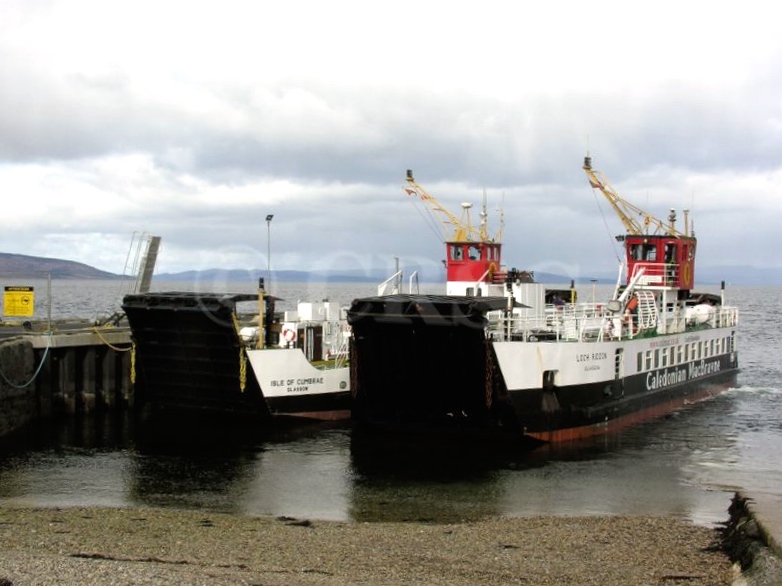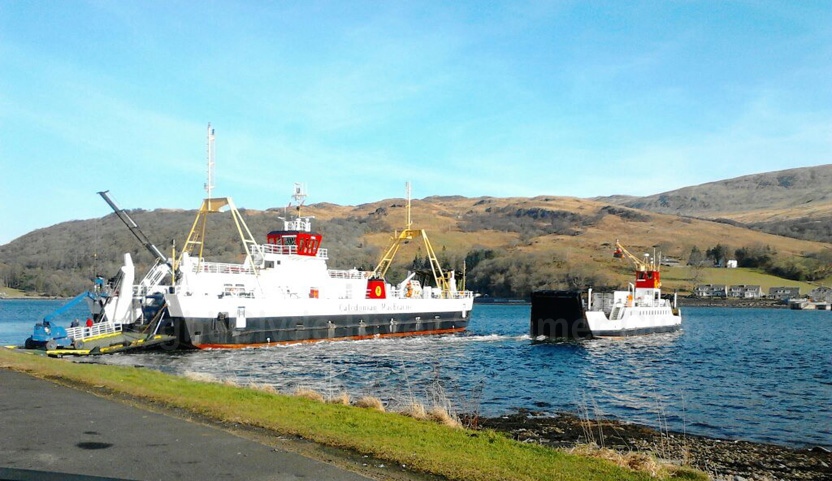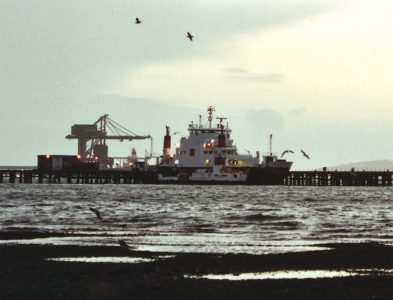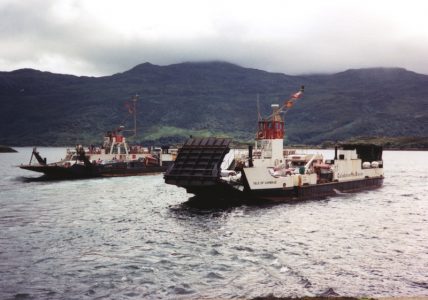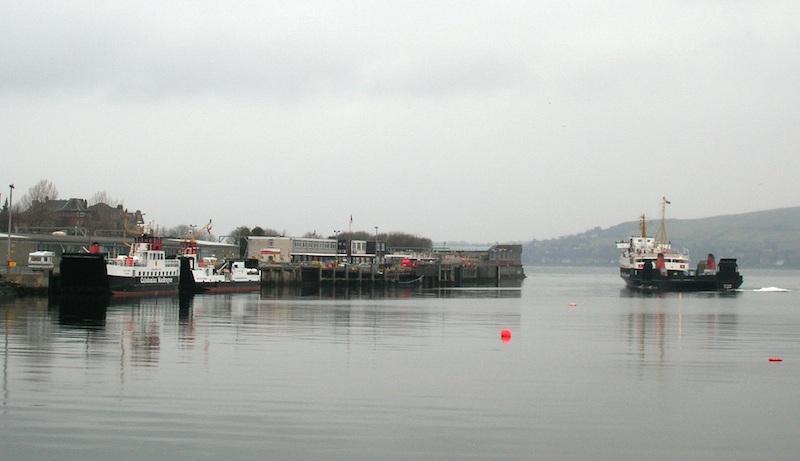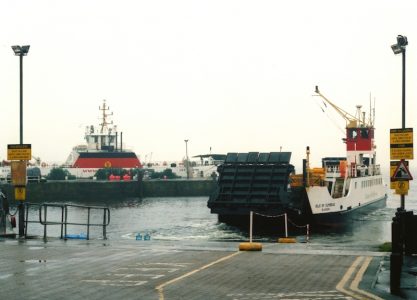
Many happy returns: Isle of Cumbrae celebrates her 40th birthday in glorious weather on 3 May 2017 at Tarbert, from where she gives an hourly service across Loch Fyne to Portavadie. Copyright Graeme Hogg
As MV Isle of Cumbrae notches up 40 years in service, Graeme Hogg sings the praises of ‘an unsung hero’.
On 4 April 2017, an anniversary occurred which has passed virtually unnoticed: it was on 4 April 1977 that MV Isle of Cumbrae formally entered service on the Largs-Cumbrae Slip route for which she had been built. For the past 40 years she has quietly gone about her business, almost under the radar of the steamer enthusiast. Such length of service is rare. The ‘Cumbrae’ has been a fine servant to Caledonian MacBrayne, and this deserves recognition.
First, some historical background. The link between Largs and Cumbrae Slip was inaugurated in March 1972 and was initially maintained by two suitably modified former Skye ferries, Coruisk and Largs (ex Kyleakin), with occasional support from one of the new ‘Island’ class ferries as traffic increased.
The service to the Tattie Pier, as it was referred to in the early days, proved to be a great success. Since the start of the car ferry era Millport had been poorly served by comparison with the other larger resorts on the Clyde, only enjoying a regular all-day car ferry service for the first time through the winter of 1971-72 courtesy of Cowal, which had been released from her Fairlie-Brodick-Tarbert service. Until then, cars were conveyed to Cumbrae by one of the ABC car ferries on a fairly irregular, although increasingly frequent basis.
By the mid 1970s it was clear that the two small ex-Skye ferries were inadequate for the burgeoning traffic, both because of their limited capacity and because, as bow loaders, vehicles had to reverse on or off the ships, with consequent delays to turn-round times, especially during busy periods. It was decided that a larger, drive-through ferry was required, and an order was duly placed with Ailsa Shipbuilding Company Limited of Troon, for what was essentially a scaled down version of the then current Skye ferries Kyleakin and Lochalsh. The contract price was £400,000 and the name was suggested by Millport schoolchildren.
Isle of Cumbrae was launched in late 1976 and was ready for service by the end of March 1977. In keeping with what was to become a career-long low profile, CalMac had not planned to have a launching ceremony for the vessel, so the yard asked if they could have one with a very small party. The answer was yes, and the wife of Ailsa’s Chairman, Mrs Peter Hutchison, performed the ceremony. After the launch the small party retired to the Marine Hotel for a lunch and speeches.
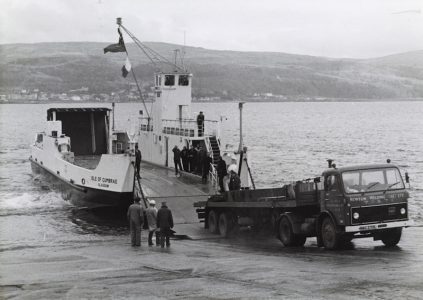
Isle of Cumbrae undergoes ramp tests at Cumbrae Slip in March 1977. Copyright The Estate of Walter and Effie Kerr
At 32 metres (105 feet) in length, Isle of Cumbrae was only about 3 metres shorter than the Skye ferries but, at 10 metres (33 feet) beam, she was almost three metres narrower and so had a 30% smaller capacity, being able to carry 18 cars and 160 passengers, the latter accommodated in a narrow saloon running along the starboard side of the vessel, as well as on the open deck above. She was fitted with two Gardner diesel engines, mounted diagonally in the hull to drive two Voith Schneider units located on the starboard side forward and port side aft. These made her very manoeuvrable, but resulted in a modest 8.5 knot service speed.
Her trials went well in almost all respects. However, it was discovered her emergency fire pump, which operated perfectly well when the ship was stationary, functioned hardly at all when the ship was underway. Much head scratching ensued as there was no obvious mechanical problem.
Eventually, it was concluded that the action of the propulsion units and the flat bottom created air bubbles which hindered the effective operation of the pump by preventing the entry of sea water. The solution was to extend and modify the suction pipes.
When compared with all later CalMac small ferries, Isle of Cumbrae’s bulwarks round the car deck are much lower. This benefits the passengers who have a much better view of the passing scene from the car deck, but limits her usefulness on more exposed routes, especially in winter.
She presented a neat appearance, which has changed little in her 40 years. The only outward signs of change are that in early 1994, during her winter refit, a crew mess room was installed aft of the passenger saloon, and the top deck was extended to cover it, so that she no longer appears symmetrical fore and aft. The other change was cosmetic. As built, her wheelhouse was painted white and carried the CalMac funnel symbol on each side.
Following the introduction of the ‘Loch’ Class ferries in 1986 and in common with them, her wheelhouse was painted red with a black top early in 1987. An intriguing feature of the ship after this change was that she acquired two red lions on yellow discs on the sides of the wheelhouse. Unlike most recent representations of the lions, hers are sheet metal and attached on short rods, in a similar fashion to those given to the ‘Maids’ and ABC car ferries in 1965. Were these lions hand-me-downs from one of these ships? They certainly seem to be a similar size, but do lack some of the detailing. Perhaps someone knows the answer.
Internally, the only significant change over the years has been her re-engining in early 2002 with Scania diesels. It is not recorded if this has improved her speed. Mechanically, she has been reasonably reliable over the years, although she has suffered ramp problems and the occasional engine and propulsion unit problems. By today’s standards, she is an unsophisticated vessel and there should be less to go wrong. On the other hand, she is now an old lady and is bound to have her issues from time to time.
Isle of Cumbrae’s activities over her career fall into three main phases. Phase One was the service for which she was built. After some teething problems with her ramps, she quickly settled into her role as the main connection for Cumbrae, summer and winter. Those problems arose because her ramps had been designed to be lowered onto the slipway once the vessel had come to a halt, whereas they were being lowered on approach and used to help act as brakes as they slid up the slipway. Various individual parts were increased in size or strengthened, but the problem was only really solved at a much later date when a new, stronger set of ramps was fitted.
In the off season, she operated mostly on her own, other than when being overhauled. In summer, either Largs or Coruisk was back-up ferry at peak times. Keppel was also still on hand to provide a passenger service to Millport in the peak summer months, but increasingly the frequency of the car ferry service and its speed saw support for the traditional sailings dwindle. At the same time, vehicle traffic continued to grow and, in common with most successful ferries, Isle of Cumbrae quickly grew the traffic almost beyond her ability to cope. She entered her ninth season on the run as the new ‘Loch’ class ferries were taking shape on the Humber. She was destined to be replaced at Largs by two of these ships which, combined, would have a greater capacity for cars and passengers and be able to offer a more frequent service. Loch Striven was delivered first and began to partner the ‘Cumbrae’. Loch Linnhe finally appeared on 3 August 1986, and the next chapter in Isle of Cumbrae’s career was about to begin.
The Lochaline-Fishnish service had also experienced significant growth in traffic and Bruernish, the ‘Island’ class ferry on the service, was struggling. Isle of Cumbrae was identified to replace her and so began her life as a member of the West Highland fleet. She soon settled in to her new role and was to spend the next 12 summers providing the back-door service to Mull. A pattern emerged whereby she would take up the service at around Easter and continue through the summer and autumn, when she would be replaced by a smaller ferry. Her winter duties involved providing cover for the two Skye ferries at Kyle of Lochalsh while they received their winter overhauls. She saw relatively little activity in these periods, as one ferry was generally able to cope with most of the winter traffic.
She did find her way to some unexpected spots, however. In early 1993 she was sent to Rum for the day to try to retrieve a lost anchor. She was unsuccessful. In January 1994, she had to take up the Raasay service for the day to cover a breakdown and she even visited Rona, off Skye, on a few occasions in March 1995 to deliver some contractors’ plant. She tended to be busier on the main service at Kyle from 1991 once the new Loch Fyne and Loch Dunvegan had entered service. They were less reliable in windy conditions owing to their high superstructure, and the ‘Cumbrae’ would often be able to maintain the service when they could not. The Skye Bridge was eventually completed in 1995 and her winter deployment at Kyle was no longer required. Instead she continued at Lochaline through the winter.
However, once again, she had been so successful on the service that she began to struggle with the traffic, particularly the ever-larger commercial vehicles she was carrying. A replacement vessel, to become Loch Alainn, was ordered from Buckie Shipyard, and on 19 July 1997 she arrived at Lochaline to take over the service. Phase Three of Isle of Cumbrae’s career could start.
She became primarily a member of the Clyde fleet again, moving initially to the Colintraive-Rhubodach service, where she operated, summer and winter, for the next two years, apart from relieving back at Lochaline and occasionally revisiting her old haunts at Largs. In 1999 it was decided to reintroduce Loch Dunvegan, which had been laid up since the opening of the Skye Bridge. Colintraive-Rhubodach was the only service considered suitable for her and she supplanted the ‘Cumbrae’ there on March 31.
Meanwhile, traffic on the relatively new Tarbert-Portavadie service had been growing and a drive-through ferry was needed to replace Rhum. Isle of Cumbrae sailed through the Kyles of Bute and round Ardlamont Point to take up the service with which she has now been associated for the longest period of her career. She sails on this service in summer only, as the winter service incorporates a crossing to Lochranza in the middle of the day. The main purpose of the winter Tarbert-Lochranza service is to provide a means of transporting gas tankers to Arran: these cannot be carried aboard Caledonian Isles with other vehicles and passengers owing to her enclosed car deck. Isle of Cumbrae, with her relatively open car deck, does not have a passenger certificate to sail to Lochranza in winter, and so she generally takes up service on Loch Fyne at the end of March, when her Summer Certificate takes effect. This means that, in some years, she will sail to Lochranza for the first week or so.
Thereafter she settles down to the daily routine of up to 12 crossings per day each way. She is well suited to the run, as heavy commercial traffic is limited and the waters are reasonably sheltered. Strong southerly or north westerly winds can be a problem and, especially in late summer, fog can sometimes be an issue. Traffic has increased steadily, especially since the introduction of Road Equivalent Tariff fares in 2015. As cars are generally larger than they were when she was built, she can no longer carry 18, but careful loading can ensure she carries about 14 if necessary. Her passenger certificate has also been scaled back to 138. She remains on the service into the start of the winter timetable but is replaced, generally by the Lochranza-Claonaig ferry, by the end of October.
Her winter deployment since 1999 has had a pattern to it, especially in the early years of the century. She would routinely relieve Loch Dunvegan at Colintraive, usually before Christmas, and Loch Fyne at Lochaline, usually early in the New Year. She has also seen service on the Oban-Lismore and Tobermory-Kilchoan crossings at different times and, on occasion, made an appearance back at Largs in emergency or to relieve Loch Alainn or Loch Shira. When not in service, she has been on standby at Rothesay in earlier days, then Rosneath and, this last winter, at Sandbank. Increasingly, she is showing her limitations when relieving on the main routes as she struggles with the bigger commercial vehicles now on the roads. As the fleet of newer ferries increases in number, they are able to provide winter reliefs at her former haunts and, since 2013, she has been laid-up in winter.

The bridge controls may betray her age but Isle of Cumbrae remains ‘a good ship to work’. Copyright Andrew Clark
The end of her career looked imminent in 2014 as the second of the ‘Literary’ class vessels, Lochinvar, finally entered service as Isle of Cumbrae’s intended replacement at Tarbert-Portavadie. It was widely expected she would be withdrawn and disposed of. However, Lochinvar suffered numerous teething problems and the ‘Cumbrae’ was kept on standby in Tarbert Harbour and frequently had to sail on the service as the latest defect on Lochinvar was remedied. Nevertheless, she was expected to be surplus to requirements after the 2014 season.
She was, in fact, retained as cover at Tarbert again in 2015, seeing service on that run occasionally and back at Largs-Cumbrae Slip. The next twist in the tale saw Lochinvar redeployed in 2016 as part of the Mallaig-Armadale flotilla, following Coruisk’s move to Oban as second vessel on the Craignure run. As a result, Isle of Cumbrae re-appeared on the Tarbert-Portavadie crossing for the season. Following another reshuffle for 2017, Lochinvar is now on Isle of Cumbrae’s old Lochaline-Fishnish route, so the ‘Cumbrae’ remains the Tarbert-Portavadie ferry, providing sterling service.
She must surely now be on borrowed time and certainly looks her age, but her crew have an affection for her, regarding her as a “good ship to work”. Her age and relative fragility were illustrated when, to complete this article and take some photographs of her, I planned a trip from Portavadie to Tarbert and back on April 12. I arrived at Portavadie to discover the service was suspended “for technical reasons”. It transpired that one of her main engines had a serious issue, which resulted in her limping on one engine to James Watt Dock to have the ailing engine replaced. Loch Riddon and then Loch Linnhe had to deputise for her for over a month, and completion of this piece had to await her return to service, which finally was possible on May 3.
How much longer she will be with us is hard to tell, but she has been a great servant to her owners and operators, has sailed to some unexpected locations, and deserves to be a bit less of an unsung hero.
“MV Isle of Cumbrae, this is your life” — 40th BIRTHDAY GREETINGS FROM FLEETMATES PAST AND PRESENT:
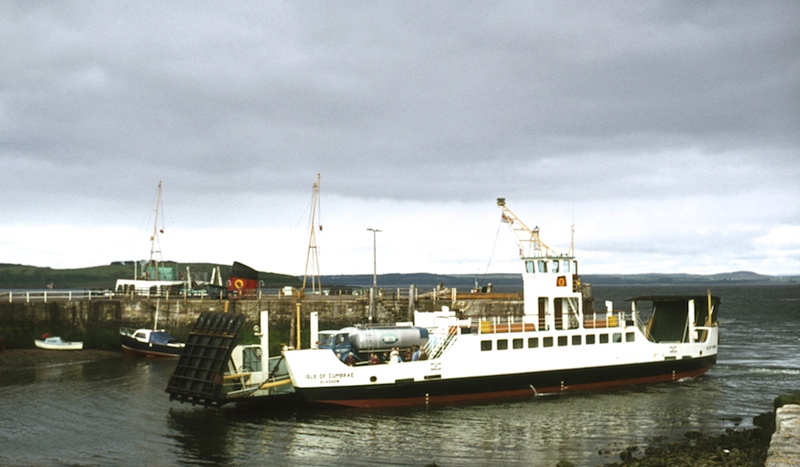
The two Cumbraes: Maid of Cumbrae (at outer berth) and Isle of Cumbrae at Largs in 1978. Copyright Walter Bowie
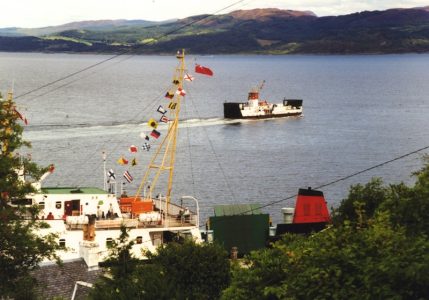
Heading off to Portavadie past Saturn at Tarbert pier on 19 August 1999. Copyright CRSC Archive Collection

Arriving at Tarbert on 27 June 2016 as Waverley approaches the Columba pier. Copyright CRSC Archive Collection

Like Western Ferries’ vessels, but unlike more up-to-date CalMac fleetmates, Isle of Cumbrae offers passengers unrestricted access to the car deck, giving them an immediate sense of the ship cleaving through the water. Copyright Graeme Hogg
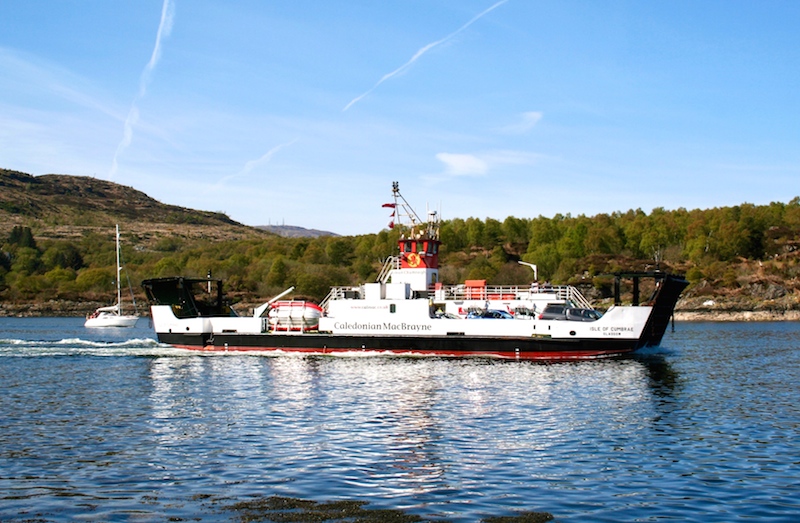
Still looking good after 40 years: Isle of Cumbrae leaving Tarbert on 3 May 2017. Copyright Graeme Hogg
Catch up with all CRSC’s other posts at News & Reports












